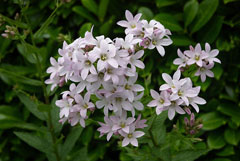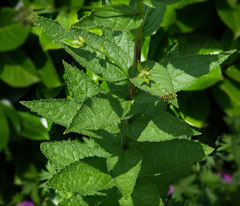 |
|
http://commons.wikimedia.org/wiki/User:Wouterhagens |
 |
| http://commons.wikimedia.org/wiki/User:Wouterhagens |
Translate this page:
Summary
Physical Characteristics

 Campanula lactiflora is a PERENNIAL growing to 1 m (3ft 3in) by 0.8 m (2ft 7in).
Campanula lactiflora is a PERENNIAL growing to 1 m (3ft 3in) by 0.8 m (2ft 7in).
See above for USDA hardiness. It is hardy to UK zone 5. It is in flower from July to August. The species is hermaphrodite (has both male and female organs). The plant is self-fertile.
Suitable for: light (sandy) and medium (loamy) soils. Suitable pH: mildly acid, neutral and basic (mildly alkaline) soils. It can grow in semi-shade (light woodland) or no shade. It prefers moist soil.
UK Hardiness Map
US Hardiness Map
Synonyms
Plant Habitats
Woodland Garden Sunny Edge; Dappled Shade; Cultivated Beds;
Edible Uses
Edible Parts: Flowers Leaves
Edible Uses:
Leaves - raw or cooked. A mild flavour with a pleasant sweetness[K]. Flowers - raw. A decorative and tasty addition to salads[K].
References More on Edible Uses
Medicinal Uses
Plants For A Future can not take any responsibility for any adverse effects from the use of plants. Always seek advice from a professional before using a plant medicinally.
None known
References More on Medicinal Uses
The Bookshop: Edible Plant Books
Our Latest books on Perennial Plants For Food Forests and Permaculture Gardens in paperback or digital formats.

Edible Tropical Plants
Food Forest Plants for Hotter Conditions: 250+ Plants For Tropical Food Forests & Permaculture Gardens.
More

Edible Temperate Plants
Plants for Your Food Forest: 500 Plants for Temperate Food Forests & Permaculture Gardens.
More

More Books
PFAF have eight books available in paperback and digital formats. Browse the shop for more information.
Shop Now
Other Uses
References More on Other Uses
Cultivation details
Succeeds in most fertile well-drained soils[233], though it prefers a moist but well-drained rich sandy loam and a neutral or alkaline soil in sun or partial shade[1, 200]. A very tolerant plant, thriving even when growing in unkempt grassy areas[233]. There are some named forms, selected for their ornamental value[200]. Plants tend to be top-heavy and will need supports in windy gardens[233]. The species in this genus do not often hybridize and so seed can generally be relied upon to come true[221]. The plants are self-fertile[221]. Although usually freely set, it is quite difficult to harvest the seed since it is readily dispersed by the plant as soon as it ripens[271]. The plant often self-sows in the garden and, if potted up whilst small, the seedlings usually transplant fairly well[271]. Members of this genus are rarely if ever troubled by browsing deer or rabbits[233].
References Carbon Farming Information and Carbon Sequestration Information
Temperature Converter
Type a value in the Celsius field to convert the value to Fahrenheit:
Fahrenheit:
The PFAF Bookshop
Plants For A Future have a number of books available in paperback and digital form. Book titles include Edible Plants, Edible Perennials, Edible Trees,Edible Shrubs, Woodland Gardening, and Temperate Food Forest Plants. Our new book is Food Forest Plants For Hotter Conditions (Tropical and Sub-Tropical).
Shop Now
Plant Propagation
Seed - best sown as soon as it is ripe, otherwise surface sow spring in a cold frame. The seed usually germinates in 2 - 4 weeks at 18°c. Easy[221]. Plants, especially as they grow, resent root disturbance so, as soon as they are large enough to handle the seedlings should be pricked out into individual pots and grow them on in a cold frame for at least their first winter. It is generally better to grow the plants on in larger pots than average in order to ensure good root development[271]. Plant them out into their permanent positions in late spring or early summer, after the last expected frosts. Basal cuttings in spring. Easy[K]. Harvest the shoots when they are about 10 - 15cm long with plenty of underground stem. Pot them up into individual pots and keep them in light shade in a cold frame or greenhouse until they are rooting well. Plant them out in the summer. Division in spring or autumn. Very easy[221], larger clumps can be replanted direct into their permanent positions, though it is best to pot up smaller clumps and grow them on in a cold frame until they are rooting well. Plant them out in the summer or following spring. Another report says that it is difficult to divide the thick tenacious roots of mature plants, and that they resent the disturbance[271].
Other Names
If available other names are mentioned here
Native Range
TEMPERATE ASIA: Iran (northwest), Turkey (northeast), Azerbaijan, Georgia, Russian Federation (Checheno-Ingushetia, Dagestan, Kabardino-Balkaria, Karacaevo-Cerkesskaja Respublika, Krasnodar, North Ossetia)
Weed Potential
Right plant wrong place. We are currently updating this section.
Please note that a plant may be invasive in one area but may not in your area so it's worth checking.
Conservation Status
IUCN Red List of Threatened Plants Status :

| Related Plants
|
| Latin Name | Common Name | Habit | Height | Hardiness | Growth | Soil | Shade | Moisture | Edible | Medicinal | Other |
| Adenophora denticulata | | Perennial | 0.5 |
6-9
| | LM | N | M | 2 | 0 | |
| Adenophora divaricata | | Perennial | 1.0 |
-
| | LM | N | M | 2 | 0 | |
| Adenophora lamarkii | | Perennial | 0.6 |
5-9
| | LM | N | M | 2 | 0 | |
| Adenophora latifolia | | Perennial | 0.5 |
-
| | LM | N | M | 2 | 0 | |
| Adenophora liliifolia | Ladybells, Lilyleaf | Perennial | 0.5 |
3-8
| M | LM | N | M | 2 | 0 | |
| Adenophora nikoensis | | Perennial | 0.3 |
5-9
| | LM | N | M | 2 | 0 | |
| Adenophora remotiflora | | Perennial | 1.0 |
5-9
| | LM | N | M | 2 | 1 | |
| Adenophora stricta | Sha Shen, Ladybells | Perennial | 1.0 |
7-9
| | LM | N | M | 2 | 1 | |
| Adenophora triphylla | Nan Sha Shen | Perennial | 1.0 |
6-9
| | LM | N | M | 2 | 1 | |
| Adenophora verticillata | | Perennial | 1.0 |
6-9
| | LM | SN | M | 2 | 2 | |
| Agapanthus campanulatus | | Bulb | 0.6 |
6-9
| | LM | SN | M | 0 | 1 | |
| Asyneuma pulchellum | | Perennial | 0.0 |
-
| | LMH | SN | M | 0 | 0 | 2 |
| Asyneuma salignum | | Perennial | 0.0 |
-
| | LMH | SN | M | 0 | 0 | 2 |
| Azorina vidalii | | Shrub | 0.3 |
8-11
| | LM | N | DM | 3 | 0 | 0 |
| Campanula alliariifolia | Cornish Bellflower | Perennial | 0.7 |
3-7
| M | LM | SN | M | 3 | 0 | 3 |
| Campanula carpatica | Tussock Bellflower, Carpathian Bellflower, Carpathian Harebell | Perennial | 0.3 |
3-8
| S | LM | SN | M | 3 | 0 | 2 |
| Campanula carpatica turbinata | | Perennial | 0.3 |
3-7
| | LM | N | M | 3 | 0 | 2 |
| Campanula cochleariifolia | Fairies Thimbles | Perennial | 0.2 |
5-9
| | LM | N | M | 4 | 0 | |
| Campanula edulis | | Perennial | 0.2 |
-
| | LM | SN | M | 2 | 0 | |
| Campanula fenestrellata | Adriatic Bellflower | Perennial | 0.2 |
5-9
| M | LM | SN | M | 4 | 0 | |
| Campanula garganica | Adriatic Bellflower | Perennial | 0.2 |
4-8
| | LM | N | M | 3 | 0 | |
| Campanula glomerata | Clustered Bellflower, Dane's blood, Clustered Bellflower | Perennial | 1.0 |
4-9
| M | LM | SN | M | 4 | 0 | |
| Campanula lasiocarpa | Mountain harebell | Perennial | 0.2 |
4-8
| | L | N | M | 2 | 0 | |
| Campanula latifolia | Large Campanula, Giant bellflower | Perennial | 1.5 |
3-7
| | LM | FS | DM | 3 | 1 | |
| Campanula latiloba | | Perennial | 0.9 |
3-7
| M | LM | SN | M | 3 | 0 | 3 |
| Campanula medium | Canterbury Bells, Cup and Saucer, Canterbury Bells | Biennial | 1.2 |
6-8
| M | LM | SN | M | 2 | 0 | 1 |
| Campanula parryi | Parry's Bellflower, Idaho bellflower | Perennial | 0.3 |
3-7
| F | LM | SN | M | 2 | 1 | 2 |
| Campanula persicifolia | Harebell, Peachleaf bellflower | Perennial | 1.0 |
3-7
| | LM | SN | M | 4 | 0 | |
| Campanula portenschlagiana | Adria Bellflower | Perennial | 0.3 |
3-7
| F | LM | SN | M | 3 | 0 | 3 |
|
|
Growth: S = slow M = medium F = fast. Soil: L = light (sandy) M = medium H = heavy (clay). pH: A = acid N = neutral B = basic (alkaline). Shade: F = full shade S = semi-shade N = no shade. Moisture: D = dry M = Moist We = wet Wa = water.
Now available:
Food Forest Plants for Mediterranean Conditions
350+ Perennial Plants For Mediterranean and Drier Food Forests and Permaculture Gardens.
[Paperback and eBook]
This is the third in Plants For A Future's series of plant guides for food forests tailored to
specific climate zones. Following volumes on temperate and tropical ecosystems, this book focuses
on species suited to Mediterranean conditions—regions with hot, dry summers and cool, wet winters,
often facing the added challenge of climate change.
Read More
Expert comment
Author
Bieb.
Botanical References
200
Links / References
For a list of references used on this page please go here
Readers comment
| Add a comment |
|
If you have important information about this plant that may help other users please add a comment or link below. Only comments or links that are felt to be directly relevant to a plant will be included. If you think a comment/link or information contained on this page is inaccurate or misleading we would welcome your feedback at [email protected]. If you have questions about a plant please use the Forum on this website as we do not have the resources to answer questions ourselves.
* Please note: the comments by website users are not necessarily those held by PFAF and may give misleading or inaccurate information.
To leave a comment please Register or login here All comments need to be approved so will not appear immediately.
|
Subject : Campanula lactiflora
|
|
|
|